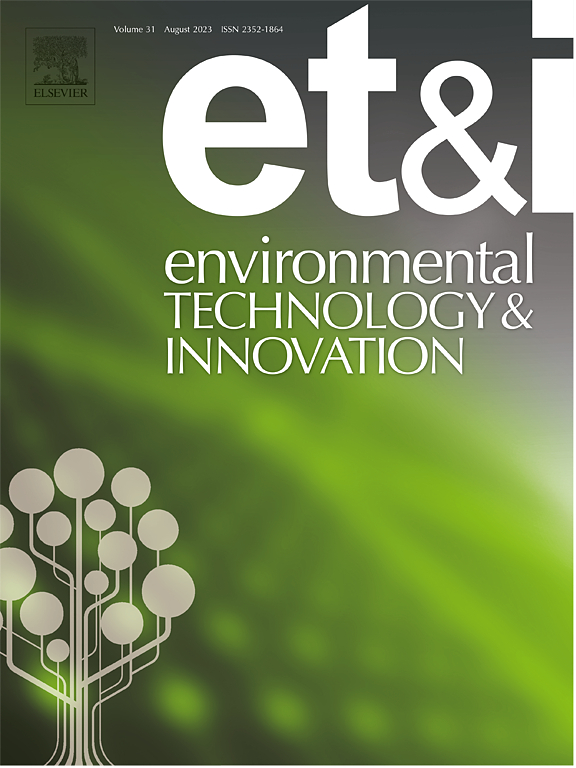厌氧微生物预处理后秸秆还田对土壤固碳减排的影响
IF 6.7
2区 环境科学与生态学
Q1 BIOTECHNOLOGY & APPLIED MICROBIOLOGY
引用次数: 0
摘要
土壤固碳效益对农业发展至关重要,而不合理的农业废弃物处理做法可能导致大量的碳排放。秸秆还田可提高土壤有机碳,加快秸秆降解的策略对农业固碳具有重要意义。厌氧菌在加速木质纤维素降解方面表现出很强的能力。但秸秆对碳转化过程的影响,以及对土壤碳的激发作用,还有待进一步探讨。本研究利用以厌氧菌为主的瘤胃微生物对秸秆进行预处理,并采用同位素示踪法模拟秸秆还本后的碳转化。13c标记秸秆预处理6 小时显著提高其分解率79.37 %。在累积CH4排放通量增加的同时,随着产甲烷相关mcrA基因丰度的增加,土壤总碳含量在60 d内增加了61.79 %。土壤酶活性显著提高,有利于木质纤维素的分解。典型对应分析表明,CH4排放归因于厌氧菌丰度的增加,而CO2排放增加与土壤固碳有关。同时,变形菌门参与土壤固碳和二氧化碳生产。这些结果表明,预处理6小时后,厌氧微生物在加速秸秆降解速度和提高土壤碳含量方面表现出高效率。厌氧微生物转化固体废物的能力已经得到证明,并突出了它们在农业废物管理和碳固存方面的强大潜力。本文章由计算机程序翻译,如有差异,请以英文原文为准。
Effects of straw returning after anaerobic microbial pretreatment on soil carbon sequestration and emission reduction
Soil carbon sequestration benefits are critical for agricultural development, and irrational agricultural waste disposal practices can lead to significant carbon emissions. Returning straw is known to enhance soil organic carbon, making strategies to accelerate straw degradation highly valuable for agricultural carbon sequestration. Anaerobes have demonstrated strong capabilities in accelerating lignocellulose degradation. However, the influence of straw on the transformation process of carbon, and the priming effect of soil carbon, needs to be further explored. This study utilized rumen microorganisms with mainly anaerobes for straw pretreatment, and employed isotope tracer method to simulate carbon transformation after straw returning. The pretreatment of 13C-labelled straw with RMs for 6 hours significantly increased its decomposition rate by 79.37 %. While the cumulative CH4 emission flux rose, along with an increase in the abundance of methanogen-associated mcrA genes, the total soil carbon content increased by 61.79 % over a 60-day experimental period. Enzyme activities in the soil increased significantly, facilitating lignocellulose breakdown. Canonical correspondence analysis indicated that CH4 emissions were attributed to increased abundance of the anaerobes, while increased CO2 emissions were associated with soil carbon sequestration. Meanwhile, the Proteobacteria is involved in soil carbon sequestration and CO2 production. These results suggest that anaerobic microorganisms exhibit high efficiency in accelerating straw degradation rates and enhancing soil carbon content following a 6-hour pretreatment of straw. The capacity of anaerobic microorganisms to convert solid waste has been shown, and highlights their robust potential for agricultural waste management and carbon sequestration.
求助全文
通过发布文献求助,成功后即可免费获取论文全文。
去求助
来源期刊

Environmental Technology & Innovation
Environmental Science-General Environmental Science
CiteScore
14.00
自引率
4.20%
发文量
435
审稿时长
74 days
期刊介绍:
Environmental Technology & Innovation adopts a challenge-oriented approach to solutions by integrating natural sciences to promote a sustainable future. The journal aims to foster the creation and development of innovative products, technologies, and ideas that enhance the environment, with impacts across soil, air, water, and food in rural and urban areas.
As a platform for disseminating scientific evidence for environmental protection and sustainable development, the journal emphasizes fundamental science, methodologies, tools, techniques, and policy considerations. It emphasizes the importance of science and technology in environmental benefits, including smarter, cleaner technologies for environmental protection, more efficient resource processing methods, and the evidence supporting their effectiveness.
 求助内容:
求助内容: 应助结果提醒方式:
应助结果提醒方式:


